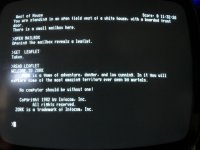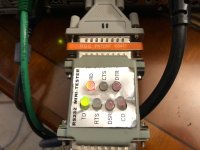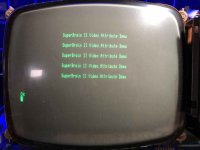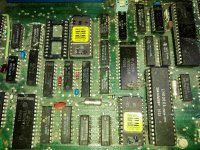Witchy
Experienced Member
Hi folks,
Since I can't, currently, make cpmtools read any of the Superbrain disk images I have I thought I'd try kermit for file transfers since I already have a distribution of 4.03 on one of the disks. Trouble is I don't know which port it was built for. The PC end is Win10 with an FTDI USB-serial converter (COM4).
(I should point out that I'm well versed in RS232 foibles and all the swearing and gnashing of teeth involved therein, but having typed all this I'm now having a nagging doubt about USB converters but with flow control off then the lack of control signals shouldn't be a problem)
Thankfully I remembered how I transferred files down to my Exidy Sorcerer initially using a terminal emulator called RealTerm. Setting both 'Brain and PC baud rates to 300 I squirted text down the main port with PIP FOO=RDR:[E] which echoed what I was typing on the PC end and a CTRL-Z on the PC end wrote the file to disk. Splendid. Main port works. 9600 baud is OK too.
Running Kermit 4.03 just locks the machine up whenever I do anything involving the serial port however, slightly frustrating since it's difficult to pinpoint WHAT makes the machine hang. I know the comms work fine, at least on the main port. Aux port also locks up with flow control on or off.
I grabbed the oldest downloadable Kermit-80 source distro which is 4.11 and split the main CPSKER.HEX into 6 easily transmittable chunks, sent them down to the 'brain then joined them all together with PIP CPSKER.HEX=KER1,KER2,KER3,KER,KER5,KER6. I also sent down CPVBRA.HEX and CPVBRM.HEX which are Superbrain specific modules for using the Aux port and Main port respectively, as well as MLOAD.HEX to build everything.
Joining them together was as easy as
LOAD MLOAD
MLOAD K411AUX.COM=CPSKER.HEX,CPVBRA.HEX
MLOAD K411MAIN.COM=CPSKER.HEX,CPVBRM.HEX
This gave me 2 kermit executables which run as expected.
However, with kermit-95 on the PC set to COM4/9600/8/N/1 I just can't make text files go in either direction, the 2 sides act like the other doesn't exist. I know the main port works so K411MAIN should at least show that it's making an effort. I need to grab the same serial sniffer I used when debugging the Sorcerer, it was a very handy thing to have.
Am I right in thinking that once the comm parameters are set then Kermit should just work out of the box? Time to drag out a machine with a real serial port perhaps...
Cheers!
Since I can't, currently, make cpmtools read any of the Superbrain disk images I have I thought I'd try kermit for file transfers since I already have a distribution of 4.03 on one of the disks. Trouble is I don't know which port it was built for. The PC end is Win10 with an FTDI USB-serial converter (COM4).
(I should point out that I'm well versed in RS232 foibles and all the swearing and gnashing of teeth involved therein, but having typed all this I'm now having a nagging doubt about USB converters but with flow control off then the lack of control signals shouldn't be a problem)
Thankfully I remembered how I transferred files down to my Exidy Sorcerer initially using a terminal emulator called RealTerm. Setting both 'Brain and PC baud rates to 300 I squirted text down the main port with PIP FOO=RDR:[E] which echoed what I was typing on the PC end and a CTRL-Z on the PC end wrote the file to disk. Splendid. Main port works. 9600 baud is OK too.
Running Kermit 4.03 just locks the machine up whenever I do anything involving the serial port however, slightly frustrating since it's difficult to pinpoint WHAT makes the machine hang. I know the comms work fine, at least on the main port. Aux port also locks up with flow control on or off.
I grabbed the oldest downloadable Kermit-80 source distro which is 4.11 and split the main CPSKER.HEX into 6 easily transmittable chunks, sent them down to the 'brain then joined them all together with PIP CPSKER.HEX=KER1,KER2,KER3,KER,KER5,KER6. I also sent down CPVBRA.HEX and CPVBRM.HEX which are Superbrain specific modules for using the Aux port and Main port respectively, as well as MLOAD.HEX to build everything.
Joining them together was as easy as
LOAD MLOAD
MLOAD K411AUX.COM=CPSKER.HEX,CPVBRA.HEX
MLOAD K411MAIN.COM=CPSKER.HEX,CPVBRM.HEX
This gave me 2 kermit executables which run as expected.
However, with kermit-95 on the PC set to COM4/9600/8/N/1 I just can't make text files go in either direction, the 2 sides act like the other doesn't exist. I know the main port works so K411MAIN should at least show that it's making an effort. I need to grab the same serial sniffer I used when debugging the Sorcerer, it was a very handy thing to have.
Am I right in thinking that once the comm parameters are set then Kermit should just work out of the box? Time to drag out a machine with a real serial port perhaps...
Cheers!




